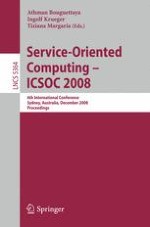This book constitutes the refereed proceedings of the 6th International Conference on Service-Oriented Computing, ICSOC 2008, held in Sydney, Australia, in December 2008. The 32 revised full papers and 20 short papers of the research track presented together with 6 industrial papers, 6 demonstration papers of the industrial track, and the abstracts of 4 keynote lectures were carefully reviewed and selected from a total of 184 submissions. The papers present original research in the field of service oriented computing, from theoretical and foundational results to empirical evaluations as well as practical and industrial experiences. Topics addressed include services foundations, business service modelling, integrating systems of systems using services, service engineering, service assembly, service management, SOA runtime, quality of service, service applications (grid, e-science, government, etc.), as well as business and economical aspects of services.
